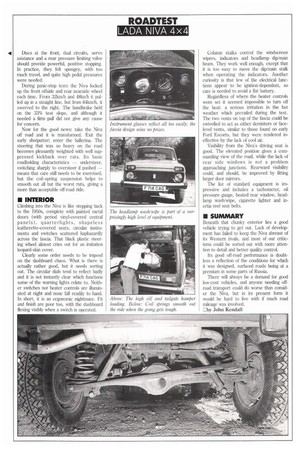ROADTEST LADA NIVA 4x4
Page 44

If you've noticed an error in this article please click here to report it so we can fix it.
Discs at the front, dual circuits, servo asistance and a rear pressure limiting valve should provide powerful, positive stopping. In practice, they felt spongey, with too much travel, and quite high pedal pressures were needed.
During panic-stop tests the Niva locked up the front offside and rear nearside wheel each time. From 32km/h and 48knili it pulled up in a straight line, but from 64knaih, it swerved to the right. The handbrake held on the 33% test slope, and although it needed a firm pull did not give any cause for concern.
Now for the good news: take the Niva off road and it is transformed. Exit the surly shotputter; enter the ballerina. The steering that was so heavy on the road becomes pleasantly weighted with well suppressed kickback over ruts. Its basic roadholding characteristics — understeer, switching sharply to oversteer if pushed — means that care still needs to be exercised, but the coil-spring suspension helps to smooth out all but the worst ruts, giving a more than acceptable off-road ride.
Climbing into the Niva is like stepping back to the 1950s, complete with painted metal doors (with period vinyl-covered central panels), quarterlights, shapeless leatherette-covered seats, circular instruments and switches scattered haphazardly across the fascia. That black plastic steering wheel almost cries out for an imitation leopard-skin cover.
Clearly some order needs to be imposd on the dashboard chaos. What is there is actually rather good, but it needs sorting out. The circular dials tend to reflect badly and it is not instantly clear which functions some of the warning lights relate to. Neither switches nor heater controls are illuminated at night and none fall readily to hand. In short, it is an ergonomic nightmare. Fit and finish are poor too, with the dashboard flexing visibly when a switch is operated. Column stalks control the windscreen wipers, indicators and headlamp dip/main beam. They work well enough, except that it is too easy to move the dip/main stalk when operating the indicators. Another curiosity is that few of the electrical functions appear to be ignition-dependent, so care is needed to avoid a flat battery.
Regardless of where the heater controls were set it seemed impossible to turn off the heat: a serious irritation in the hot weather which prevailed during the test. The two vents on top of the fascia could be swivelled to act as either demisters or facelevel vents, similar to those found on early Ford Escorts, but they were rendered ineffective by the lack of cool air.
Visibility from the Niva's driving seat is good. The elevated position gives a commanding view of the road, while the lack of rear side windows is not a problem approaching junctions. Rearward visibility could, and should, be improved by fitting larger door mirrors.
The list of standard equipment is impressive and includes a tachometer, oil pressure gauge, heated rear window, headlamp wash/wipe, cigarette lighter and inertia reel seat belts.
Beneath that chunky exterior lies a good vehicle trying to get out. Lack of development has failed to keep the Niva abreast of its Western rivals, and most of our criticisms could be sorted out with more attention to detail and better quality control.
Its good off-road performance is doubtless a reflection of the conditions for which it was designed, surfaced roads being at a premium in some parts of Russia.
There will always be a demand for good low-cost vehicles, and anyone needing offroad transport could do worse than consider the Niva, but in its present form it would be hard to live with if much road mileage was involved.
Eby John Kendall








































































































































